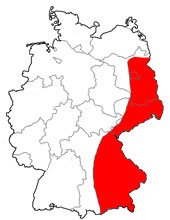Subspecies
Dicerca aino Lewis, 1863 is often treated as a subspecies or even as a synonym
of the present species. However, this is incorrect (see "Synonyms" below).
Synonyms
Buprestis acuminata Pallas, 1781 (nec DeGeer, 1774; junior primary homonym)
Dicerca acuminata (Pallas, 1781)
Latipalpis acuminata (Pallas, 1781)
Argante acuminata (Pallas, 1781)
Buprestis furcata Thunberg, 1787
Dicerca furcata (Thunberg, 1787)
Buprestis calcarata Fabricius, 1801 (doubtful; see note)
Dicerca opaca Schilsky, 1888
Dicerca obscura opaca (Schilsky, 1888)
The taxon calcarata Fabricius, 1801 is variably synonymized with the present species or with Dicerca berolinensis. Until this matter is settled I list the name in the synonymy of both species.
The taxon Dicerca aino Lewis, 1893 has previously been regarded as a synonym of the present species (e.g. Holynski 2006). However, Hass and Kubach (2015) present evidence that Dicerca aino is in fact a separate species that occurs in Asia east of the Ural mountains. Therefore, I do not include it here in the synonymy.
Dicerca acuminata (Pallas, 1781)
Latipalpis acuminata (Pallas, 1781)
Argante acuminata (Pallas, 1781)
Buprestis furcata Thunberg, 1787
Dicerca furcata (Thunberg, 1787)
Buprestis calcarata Fabricius, 1801 (doubtful; see note)
Dicerca opaca Schilsky, 1888
Dicerca obscura opaca (Schilsky, 1888)
The taxon calcarata Fabricius, 1801 is variably synonymized with the present species or with Dicerca berolinensis. Until this matter is settled I list the name in the synonymy of both species.
The taxon Dicerca aino Lewis, 1893 has previously been regarded as a synonym of the present species (e.g. Holynski 2006). However, Hass and Kubach (2015) present evidence that Dicerca aino is in fact a separate species that occurs in Asia east of the Ural mountains. Therefore, I do not include it here in the synonymy.
Identification
No information has been entered yet.
Distribution

Distribution map of Dicerca furcata in Germany.
Occurs in Sweden, Finland, Germany, Poland, Slovakia, Czech Republic, Hungary, much of eastern Europe and Russia west of the Ural mountains, and doubtfully also on the Balcans. There are also doubtful records for Austria, Switzerland and Italy, but these may be based on misidentifications or erroneous locality labels (see also Hass 2016). In Gemany there are confirmed populations in Bayern, Sachsen and Brandenburg. A single record from Baden-Württemberg might be the result of unintentional import (see Hass 2016). The species is very rare in Germany and is restricted to habitats that are also rare and threatened (bogs, marshes, open heathland).
Biology
The species is very thermophilic and requires habitats that can store heat in the soil or
produce geothermal energy. Therefore, the species prefers bogs and
marshes, heath and sandy soils. The species develops in birch (e.g.
Betula pendula). Hass (2016)
reports that the imagines overwinter at the base of the host trees,
probably in cracks of the bark, and become active in the Spring as soon
as the temperature permits. They aggregate on their host trees and mate.
Mating only takes a few minutes, and
then the females deposit the eggs on the host tree. After hatching, the
larvae
bore into the wood, where they develop for three years before they
pupate inside the tree near the bark. Eclosion then occurs in June to
August. The imagines feed on birch leaves, but also eat the bark of young twigs (Hass 2016). The imagines may overwinter several times and thus may reach an age of a few years.